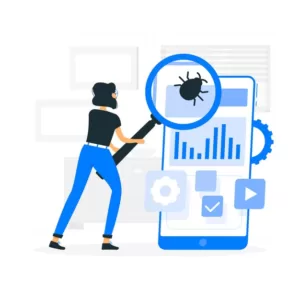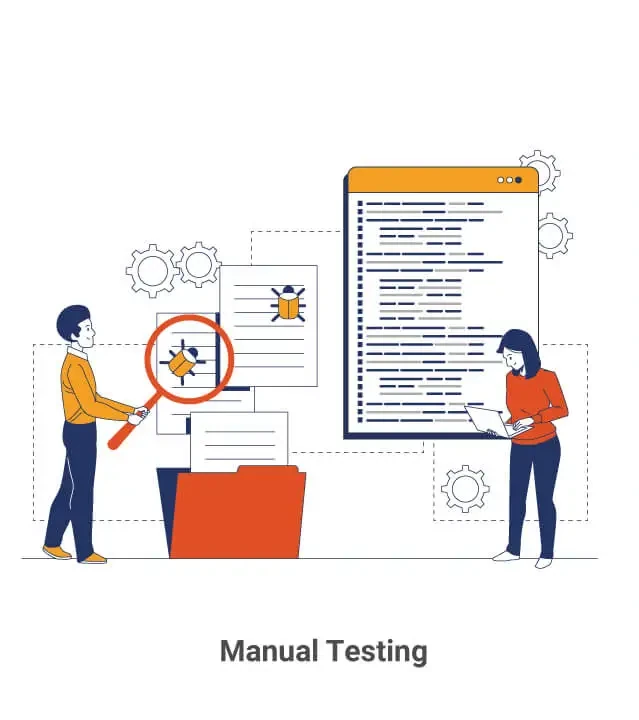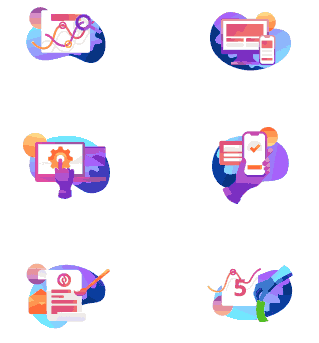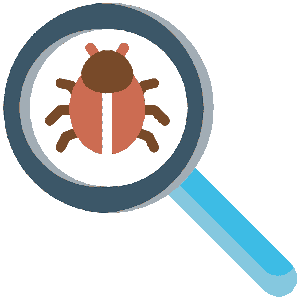We Help You Hire a Manual Tester From South America

Hiring a Manual Tester from a nearshore company can often be confusing and time-consuming. To find the best Manual Tester for your role, you need someone smart, responsible, and hardworking, as well as possessing verified skills and experience.
Our custom AI matching algorithm helps you find the perfect Engineer for your project. By combining data analysis with personal interviews, we find an excellent match for your team.
We want to help you hire a Manual Software Tester who will contribute quality code from day one. Several fast-growing startups trust our hiring process because it has been refined over several years. With QATPro, you can hire your future Manual Test Engineer.
Work to USA Hours
Since our Engineers are in Brazil, they are happy to work US hours to be able to communicate with your already existing team.
South American Prices
South American Manual Test Engineers who are eager to work with US companies have joined our team.
No Surprise Extra Costs
Our company handles personnel benefits, local employment taxes, and other employment-related expenses.
Vetted Professional Manual Testers
You can be assured you are hiring a skilled professional who has gone through our rigorous testing process when you hire a manual tester with us.
Testimonials



What is Manual Testing?

Manual testing is a process of evaluating software applications manually, without the use of automated testing tools. It involves testers executing test cases, observing the software’s behavior, and verifying whether it meets the specified requirements. This approach allows for a thorough examination of the software’s functionality, user interface, and overall user experience.
Test Case Design and Execution
In manual testing, testers design test cases based on the software requirements and execute them step-by-step. They follow predefined test scenarios and document the results. This process helps identify any deviations from expected behavior, uncover bugs or issues that may impact the software’s performance and usability.
User Interface Testing
One of the essential aspects of manual testing is evaluating the software’s user interface (UI). Testers interact with the application as end-users would, assessing the UI design, responsiveness, and ease of navigation. They ensure that the software meets user expectations in terms of aesthetics, layout, and functionality.
Exploratory Testing
Exploratory testing is a vital part of manual testing. Testers use their domain knowledge, intuition, and creativity to explore different scenarios, uncover hidden defects, and identify potential risks. It involves real-time testing without predefined scripts, allowing testers to adapt their approach and focus on areas that are more likely to have issues.
Manual Testing’s Role in Software Development
Manual testing plays a crucial role in ensuring the quality and usability of software applications. It allows for in-depth analysis of various aspects, including test case design and execution, user interface testing, and exploratory testing. Although automated testing has gained popularity, manual testing remains an integral part of the software development life cycle, providing human insights and uncovering subtle defects that may be missed by automated tools.
- Improve Quality
- Better Reliability
- Quality Assured Software
- Works closely with existing development team
- Muliple Device testing
- Test different operating systems
- Reduce Bugs
- Better Customer Experience

Claúdio Costa
Manual Tester
8+ Years of QA 7+ Years of Manual testing. Enjoys testing both the backend apis and front end of systems

André Dias
Manual Tester
12+ Years of Manual Testing 8+ Years of QA Automated Testing. Lots of experience with manual testing in the financial industry and banking

Nilton do Nascimento
Manual Tester
10+ Years of Manual Testing 8+ Years of QA and device testing. Previously worked for a number of ecommerce companies improving their reliability.
What does a Manual Tester do?
A manual tester’s job primarily revolves around evaluating software applications to ensure their quality and functionality. Their responsibilities include designing and executing test cases, identifying and documenting defects, and verifying whether the software meets the specified requirements. They meticulously follow predefined test scenarios to validate the application’s behavior and performance.
Manual testers also play a crucial role in user interface testing, assessing the software’s aesthetics, responsiveness, and ease of use. They interact with the application as end-users would, ensuring a seamless and intuitive user experience.
Additionally, manual testers often engage in exploratory testing, leveraging their domain knowledge and creativity to uncover hidden defects and potential risks. Their expertise and attention to detail contribute to delivering high-quality software products to end-users.


A Reliable Development Partner For You
Testing apps and websites requires an experienced and reliable partner. Our goal is to provide a premium and professional service to all our customers. To get your testing team off to a great start, contact us today!
How to Hire a Manual Tester?
Here are three steps you can follow in order to hire a Manual Tester with us:
Click the button below and fill in your requirements and click send. Please provide a description of whatever you need and your project.
Receiving and interviewing resumes from Manual Test Engineers. Start preparing a shortlist of professionals to interview once the proposals start coming in.
The requirements description is where you will determine your scope of work and the specific type of Manual Tester you need.
- Project Scope: From websites, APIs to apps and analytics, list all the deliverables you’ll require.
- Expected Project length: Your job post should indicate what timescale you expect the work to be completed in or if it is ongoing.
- Industry Background: If you prefer someone with certain industry experience, mention this here.
- Preferred Billing: Tell us if you prefer hourly rates or monthly bills.
How much does it cost to Hire a Manual Tester?
It is common for many factors to have an impact on the cost, such as expertise, experience, location, and market conditions.
Manual Testers who boast experience will also deliver higher-quality results, work faster, and have more specialized areas of expertise in addition to commanding higher fees.
A beginner might price their Manual Testing development services lower as they gain experience.
The hourly rates for our South American Manual Testers are:
Junior
Prices From- Works to U.S time zones
- No Recruitment Fees
- Vetted Skills & Experience
- Fulltime Working for you
- No Unreliable Freelancers
Intermediate
Prices From- Works to U.S time zones
- No Recruitment Fees
- Vetted Skills & Experience
- Fulltime Working for you
- No Unreliable Freelancers
Senior
Prices From- Works to U.S time zones
- No Recruitment Fees
- Vetted Skills & Experience
- Fulltime Working for you
- No Unreliable Freelancers
With us, you can hire a Manual Tester from South America!
Engineer prices may vary depending on exact skill and experience requirements and availability.
You’ll have to decide which one works best for your project based on its specifics.
What kind of Test Cases does a Manual Tester write?
In manual testing, testers write various types of test cases to assess the functionality, performance, and usability of software applications. These test cases provide step-by-step instructions for executing specific tests and validating the software’s behavior against expected outcomes.
Functional Test Cases
Functional test cases focus on verifying whether the software functions correctly according to the specified requirements. Testers design test cases to cover various functional aspects, such as input validation, data manipulation, calculation accuracy, and proper handling of exceptions. These test cases ensure that the software performs its intended tasks accurately and reliably.
User Interface Test Cases
User interface test cases are designed to evaluate the software’s graphical user interface (GUI) and user experience. Testers write test cases that cover aspects like layout, responsiveness, navigation, and adherence to usability principles. They verify whether the GUI elements are displayed correctly, interact with the application to ensure proper functionality, and validate that the UI meets user expectations.
Error Handling Test Cases
Error handling test cases focus on how the software handles unexpected or erroneous situations. Testers create test cases to simulate scenarios like entering invalid data, triggering error conditions, or encountering system failures. These test cases validate that the software correctly detects and responds to errors, displays appropriate error messages, and gracefully recovers from failures.
Comprehensive Testing
Manual testers write a variety of test cases, including functional, user interface, and error handling test cases, to ensure comprehensive testing of software applications. These test cases cover different aspects of the software’s behavior, performance, and user experience, allowing testers to thoroughly evaluate the application and identify any issues or deviations from expected outcomes. By designing and executing these test cases, manual testers contribute to delivering reliable, user-friendly, and high-quality software products.
What Interview Questions should you ask a Manual Tester?
Can you explain your experience with creating and executing test cases in previous projects?
This question helps assess the candidate’s proficiency in designing and executing test cases, their understanding of different testing techniques, and their ability to follow test scenarios to validate software functionality.
How do you approach user interface testing?
This question allows the candidate to showcase their expertise in evaluating the user interface, understanding UI design principles, and ensuring a seamless user experience. Look for candidates who emphasize usability, responsiveness, and adherence to UI guidelines.

Can you describe a situation where you encountered a challenging defect during your testing?
How did you handle it? This question helps evaluate the candidate’s problem-solving skills and ability to handle unexpected issues. Look for candidates who can explain their troubleshooting process, their collaboration with developers or stakeholders, and their persistence in finding a resolution.

Do You Enjoy Working Alone or within a QA team?
Manual Test engineers can have any combination of skills, so there is no right or wrong answer to this question. It may be important to you to hire an engineer who is hardworking and can function independently. In contrast, you might want someone who works well with others and isn’t stubborn.
What is your approach to exploratory testing?
This question assesses the candidate’s ability to think outside the box, their creativity in uncovering potential risks, and their adaptability in real-time testing scenarios. Look for candidates who emphasize their ability to leverage domain knowledge and intuition to discover defects and improve overall test coverage.
A Brief History of Manual Testing
Manual testing has a rich history that dates back to the early stages of software development. This approach has evolved over time, adapting to new methodologies and technologies while remaining an essential part of the testing process.
Early Stages of Software Development
During the early days of software development, manual testing was the primary method employed to evaluate software. Testers would execute test cases manually, observe the software’s behavior, and report any issues they encountered.
Structured Testing Methodologies
As structured software development methodologies emerged, manual testing gained more prominence. Testers began designing test cases based on requirements and executing them step-by-step to ensure that the software met the specified criteria.
Test Management Tools
With advancements in technology, test management tools were introduced to assist testers in organizing and tracking their test cases and results. These tools streamlined the manual testing process, allowing for better test case management and reporting.
Continued Relevance in the Era of Automation
While automation has gained traction in recent years, manual testing continues to be an integral part of the testing process. Manual testing provides a human touch, allowing testers to uncover subtle defects that may be missed by automated tools. It remains crucial for validating software functionality, ensuring a seamless user experience, and providing valuable insights into the software’s performance.
Manual Testing Adapting to Change
Manual testing has a long-standing history in software development. From its early stages to the present, manual testing has adapted to changing methodologies and technologies. While automation has its benefits, manual testing remains relevant, offering human insights and playing a vital role in ensuring the quality and usability of software applications.
Why are we the best choice to hire a Manual Tester from?
As a leading Nearshore Technology Solutions company, we provide high quality Test Engineers at competitive prices. Our goal is to provide our clients with high-performance, scalable solutions.
We provide development project acceleration or rescue by utilizing our programming prowess and project management experience. Always striving to create lasting value throughout the development of your project and beyond.
Trusted by over a hundred startups and tech companies around the world, we’ve matched hundreds of skilled Engineers to great teams.
Our Manual Testers become devoted members of your team, fully integrated into your organization.
Every Manual Test Engineer we supply goes through a vetting process to verify their communication abilities, remote work readiness, and technical skills (both for depth in QA and Software Testing but also, we check for breadth of knowledge across software development and computer science).
Cost Reduction
Companies usually outsource in order to reduce costs. Hiring software engineers from outside the United States costs less. You will also significantly reduce overall employment costs. You won’t have to pay US or European employment taxes, benefits, redundancy liabilities, or office space.
Scale Fast
Expanding and downsizing quickly can be a great competitive advantage for any industry. Outsourcing Brazilian Engineers with us will allow your business to scale up or down as you need, and with relative ease.
Professional Experience
With software development outsourcing, you’re entrusting your project to a company with extensive experience in helping businesses achieve their goals. As a result, you can feel more secure knowing that your application will be delivered on schedule and within budget.
What types of systems to Manual Testers Test?
There are various systems that manual testers test to ensure their functionality, usability, and performance. Here are some common systems that manual testers typically work with:
Web Applications
Manual testers extensively test web applications across different browsers, platforms, and devices. They verify the application’s functionality, user interface, responsiveness, and compatibility to ensure a seamless experience for users.
Mobile Apps
Manual testers play a crucial role in testing mobile applications on different operating systems (such as Android and iOS). They focus on aspects like app installation, navigation, user interface, device compatibility, and performance to ensure optimal functionality and user satisfaction.
Database Systems
Manual testers perform testing on database systems to ensure data integrity, accurate querying, and efficient storage and retrieval of information. They validate SQL queries, data manipulation, and perform tests to ensure data consistency and reliability.
Enterprise Systems
Enterprise systems encompass complex software applications used within organizations for various purposes like customer relationship management (CRM), enterprise resource planning (ERP), or human resources management. Manual testers verify these systems’ functionality, workflows, integrations, and user access rights to ensure smooth operations.
All kinds of Business Systems
Manual testers test a wide range of systems, including web applications, mobile applications, desktop applications, client-server systems, database systems, and enterprise systems. Their expertise in testing these systems ensures that software applications meet user expectations, perform reliably, and provide an excellent user experience.

- Test Websites
- Test Apps
- Test Desktop Applications
- Test APIs
- Test Databases
- Test User Interfaces
How do we test a manual tester before we hire them?

To test a manual tester, we take several approaches.
First, we assess their knowledge and understanding of software testing concepts, methodologies, and industry best practices through theoretical questions and scenario-based discussions.
Second, we evaluate their ability to design and execute effective test cases by providing sample requirements or scenarios and asking them to create test cases.
Third, we simulate real testing scenarios or provide a software application for them to manually test, observing their attention to detail, bug identification skills, and overall approach to testing.
Additionally, we review their past experience and references to gauge their proficiency and track record in manual testing. Collaboration and communication skills are also essential to assess their ability to work with development teams and effectively report bugs and issues.
How do you effectively manage Manual Testers?
When it comes to hiring Manual testers and coordinating development teams with diverse skillsets, effective management has never been more essential. A strong management structure is also essential for retaining technical talent, whether working full-time or in hybrid teams.
Align business and technical objectives by defining key results
In order to align on measurable success criteria, product owners, development managers, and architects can define objectives and key results (OKRs). Leaders define the objective, then the team discusses, debates, and determines the key results in collaboration with the leaders.
An important best practice is to define OKRs on a regular basis. If OKRs are defined and measured too frequently, it can be expensive; if they are too infrequent, teams may lose sight of the goals. Here are two examples:
Meaningful improvements in application reliability may include reducing page response time, increasing app availability, or reducing error rates.
“Improving deployment reliability” may involve reducing build time and automating tests.

Have a reliable process and choose a methodology
Agile methodologies have been praised by many Manual Testers. Decide on a release schedule or sprint schedule.
The typical one-week sprint is almost too short to complete big user stories, but the two-week sprint usually allows time for vacations and unexpected problems. Engineers need daily stand-up meetings to keep track of what everyone is working on (and ask for help when needed).
Good team communication and information sharing are essential
To be an effective engineering manager, your team needs to be connected to your customers as well as the rest of the organization. A QA Web Engineer should be able to understand your customers, target audience, and the rest of the organization’s needs and constraints.
Defining your target audience’s needs helps them define a path to delivering useful and profitable software. QA Engineers should communicate directly with external teams and partners when necessary while relaying relevant information to them when necessary.
We can help you manage your testing and development team effectively
We can help you manage your testing and development team and implement Agile methodologies. These principles emphasize people and exchanges over procedures and devices, working software over comprehensive documentation, customer relationships over contract negotiations, and reacting to change over planning.
There is more to implementing Agile than adopting an Agile methodology. We help you choose the right Agile methodology after looking into your business and taking time to understand how you work. Choosing the right working methodology for you results in increased productivity, shorter time-to-market, and fewer defects.

How long does the average Manual Tester stay in a job?
After you hire a Manual Test Engineer in the US on average, they stay between 1.8 and 3.2 years in the job, with larger companies tending to keep workers longer. The average time spent in Brazil is between 2.4 and 4.1 years, with those in Sao Paulo spending the least time. In the past, it wasn’t unusual for someone to spend their entire career at one company.
Experienced Manual Testers may transition from job to job fairly quickly, seeking new opportunities and more money, as such longevity is no longer commonplace. With a low unemployment rate and a desperate need for professionals with mobile, cloud, and other vital skills, the most in-demand tech pros can migrate between jobs (or even freelancing) fairly easily in this market. Communication with employees is key, and we offer perks to attract and retain top talent.

Frequently Asked Questions (FAQs)
Our services are trusted by hundreds of startups and tech companies worldwide, and we have matched hundreds of skilled Test Engineers to great development teams in the US, UK and Canada. Every Selenium Engineer in our network goes through a vetting process to verify their communication abilities, remote work readiness, and technical skills, both for depth in Selenium and breadth across the greater programming domain.
The job description of a Manual Tester should include the following:
Testing, implementing, and managing software
New program testing and evaluation
Enhancing existing programs by identifying areas for improvement
Coding in an efficient manner
Analyzing operational feasibility
Establishing procedures for quality assurance
Implementing software tools, processes, and metrics
Upgrades and maintenance of existing systems
Assisting other Engineers, UX designers, and business analysts with their tasks
It’s not enough to just ship features; your software needs to help your business succeed. In order to better understand what you’re building, for whom, and why, we’ll begin our collaboration with a discovery process.
Our headquarters are in Sao Paulo, Brazil. We have clients from all over the world. We have successfully collaborated with companies in North America, Asia, the Middle East, and Europe. A good understanding of each client and excellent English communication skills help the process run smoothly.
We can work with you to scale the team down as needed and make sure you have the correct skills required for each project phase.
All Types! You can hire a Manual Tester on a full-time, part-time, or contract-to-hire basis at QATPro. You can find a Manual tester in our global network of test engineers. Engineers who work remotely for us are all mid- and senior-level professionals, ready to test right away.

